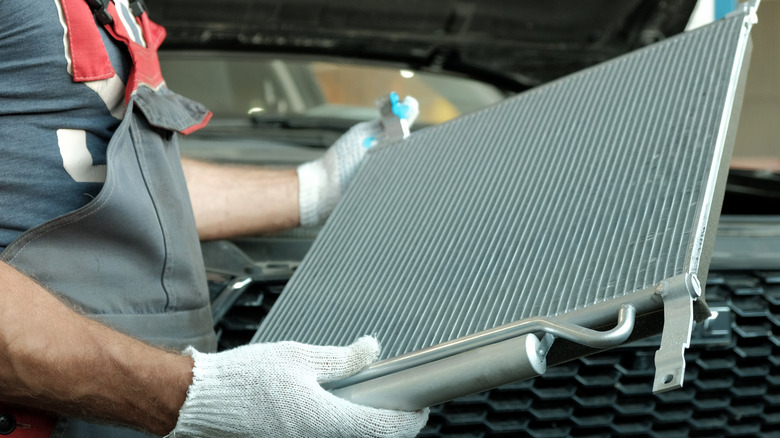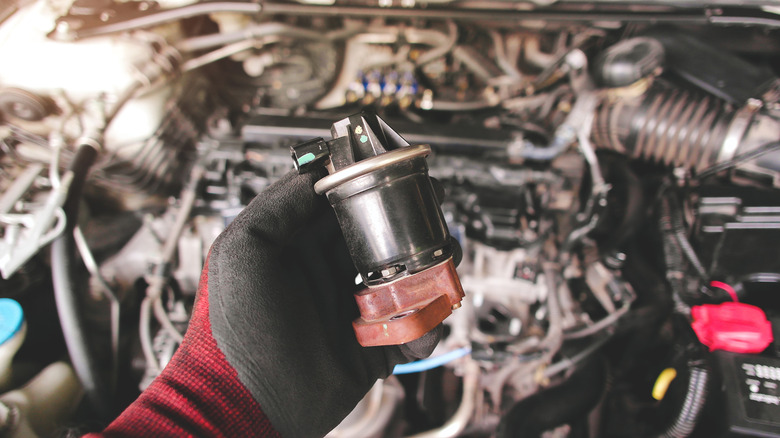The Most Common Problems With Ford's 6.4L Power Stroke Diesel Engine
When Ford launched the 6.4L Power Stroke V-8 diesel engine in 2007 as part of its F-Series trucks, Ford enthusiasts expected it to be unlike its predecessor, the 6.0L Power Stroke. Although Ford produced several reliable engines over the years, the 6.0L Power Stroke was, unfortunately, a disappointment. The all-new 6.4L engine, which was created by International, was, thus, expected to redeem the company's reputation in the diesel truck market.
The 6.4L engine initially met these expectations, thanks to its common rail design, as opposed to its predecessor's HEUI design. The common rail design meant reduced operation noise as well as more torque and horsepower for the engine. Additionally, simple modifications allowed Ford owners to unlock even better performance from the 6.4L Power Stroke, further driving up demand and interest in vehicles with this engine. However, over time, the 6.4L Power Stroke's poor design and the failure of its emissions-control devices began to cause issues that Ford owners would find were pretty expensive to fix.
The engine soon gained a reputation for being unreliable, and it was replaced in just a few short years by the more efficient 6.7L Power Stroke diesel engine that Ford built in-house. That said, although the 6.4L Power Stroke V-8 had a brief run, its power specs were nothing short of impressive. If you're considering buying a used Ford equipped with this engine or already own one, here are the common issues you'll want to watch out for.
Oil dilution
A common issue that Ford owners have experienced with the 6.4L Power Stroke is oil dilution. This happens when the diesel fuel makes its way into the engine's oil system during the active regeneration process. In the case of the 6.4L Power Stroke, additional fuel is injected into the exhaust stream to aid combustion during regeneration. However, not all of the fuel gets used up, and the residual fuel seeps into the engine's oil system, contaminating the oil.
Contaminated oil cannot lubricate the engine's moving parts adequately. This makes the internal parts of the engine more susceptible to wear and tear, and, ultimately, engine failure. Given this, if you own a truck with a 6.4l Power Stroke, make sure to keep an eye on the oil level and its quality, and don't skip any scheduled oil changes. An increase in the oil level could indicate dilution, and you'll need to address this immediately to avoid extensive engine damage. In this case, it's best not to wait until you hit the 10,000-mile mark for an oil change.
Additionally, each time you change the oil, ensure that you're using a high-quality oil that meets the manufacturer's specifications. Even if the oil levels remain constant and undiluted, consider scheduling service appointments for your truck every 5,000 miles, at the very least.
Radiator leaks
The 6.4L Power Stroke engine is known to develop radiator leaks due to its poor design. A leak of this nature can cause your engine to overheat, resulting in significant engine damage over time. So, if you own a Ford with a 6.4L Power Stroke, be sure to check under your truck for a puddle of coolant. Other signs of a radiator leak include a sudden drop in the coolant level instead of a gradual reduction, and corrosion marks on the radiator.
While sealants may help temporarily stop a radiator leak, the best long-term solution is to replace the stock radiator with a solid aftermarket option. You can also consider using radiator support tie bars to reinforce the radiator and keep the system and radiator hose protected to prevent the possibility of leaks in the future. If you're considering purchasing radiator support bars, make sure you're buying one that is capable of resisting high temperatures and corrosion and is of the right dimensions.
Cracked pistons
The proper functioning of the pistons is what helps the engine create power to move your truck. In the case of the 6.4L Power Stroke diesel engine, the poor piston design makes the fuel bowl prone to developing cracks. If this is not dealt with during your regular service check, the cracks could extend along the length of the piston, compromising its integrity. Eventually, this could lead to catastrophic failure.
Some telltale signs of piston failure are engine knocking sounds, a loss of power when you accelerate, excessive smoke from the exhaust pipes, increased oil consumption, and misfires. Eventually, cracked pistons could cause your engine to break down, leaving you stranded in the middle of nowhere. Unfortunately, while fixes for the 6.4L Power Stroke engine's problems are sometimes affordable and easy to implement, replacing your cracked or faulty OEM pistons with aftermarket options can get fairly expensive. That said, if you're set on owning a Ford truck with this engine, replacing the pistons is often necessary.
EGR system failure
The EGR (exhaust gas recirculation) system in Ford's 6.4L Power Stroke engines is known to develop issues over time, usually around the 100,000-mile mark. This system helps reduce the temperature of the exhaust gases by transferring some of the heat to the coolant before it is recirculated back into the engine's intake. Not only does this process keep the inner components of the engine from overheating, but it is also instrumental in reducing nitrogen oxide emissions. However, factors like soot building up in the EGR pipe or valve, reduced coolant levels due to leaks, or even frequently driving your Ford in conditions that require the engine to work harder than usual can cause the EGR system to fail prematurely, resulting in a range of issues, including increased emissions and reduced engine efficiency.
The 6.4L Power Stroke diesel engine has two coolers, which will ideally have to be replaced with aftermarket options to ensure the proper functioning of the EGR system. However, replacing plugged coolers can get expensive, so be sure to clean the coolers frequently to keep them free of buildup. Keep in mind that the latter is a temporary fix, and you will, in all likelihood, have to spring for new aftermarket coolers in time.
Unimpressive mileage
Although the 6.4L Power Stroke is a powerful engine, it suffers in terms of fuel efficiency. This is primarily because of the diesel particulate filter (DPF), which was added in response to the newly introduced stringent emission control regulations. The DPF consumes more fuel during the active regeneration process, helping it achieve the high exhaust temperatures needed to burn soot. Unfortunately, frequent active regeneration cycles, which happen when you drive in heavy traffic, cause more fuel to burn. This can be extremely frustrating, especially if you're hoping to commute long distances in your Ford truck.
Some Ford owners opt for a DPF system deletion as a workaround. Keep in mind, though, that this can cause other issues, including warranty invalidation and legal implications if you reside in an area where DPF removal is illegal. However, you can invest in a cold air intake system and CARB-approved tuner to improve fuel efficiency, without violating any local emissions regulations. When buying these accessories, be sure to do your due diligence and choose options from well-reputed providers. Changing your driving habits is another way to use less gas.





